The itinerary for your trip to China probably includes sightseeing at popular destinations such as the Great Wall or Tiananmen Square. Maybe you’ve scheduled some time to play with the pandas or enjoy local food. But did you know that China offers a multitude of incredible caves for exploration?
If you’re headed to the Middle Kingdom, make sure to include a visit to at least one of the destinations on our list. These incredible caves in China are some of the most beautiful, unique, and mysterious natural and human-made wonders in the entire world.
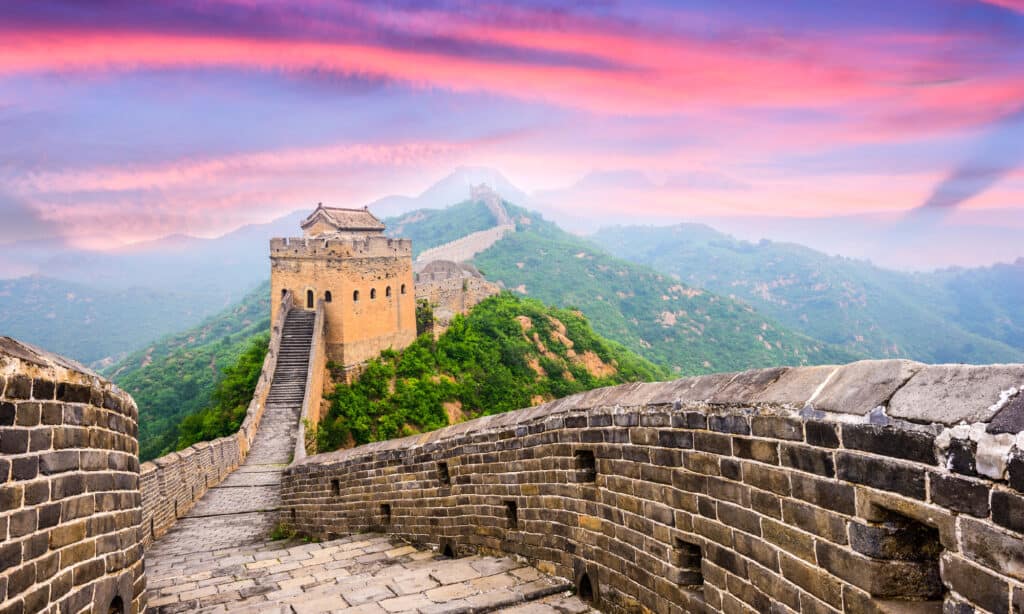
While the Great Wall of China is a must-see destination, the caves below are also worth your time.
©iStock.com/SeanPavonePhoto
1. Longyou Caves
The Most Mysterious Cave in China
No one yet knows why, how, or who constructed the Longyou Caves in the Zhejiang Province of China, making them an ongoing puzzle for archaeologists and the country’s most mysterious caves. They are a system of 24 caves with five caverns and 19 smaller caves. Each cavern measures between 59-111 feet with heights up to 65 feet.
Farmers found the caves when they drained several ponds in the area in 1992. Initially, experts thought the caves were a natural wonder. However, based on the cave’s unique characteristics, they now believe the caves are human-made. A sophisticated water collection and drainage system, as well as the caverns’ orientation to natural sunlight (which allows for interior illumination), both point to creative human design and build.
Glazed clay pots found in the cavern floor date to the Western Han Dynasty from 206 BC to AD 23, which means the caves are around 2,000 years old.
Very little evidence beyond those artifacts offer scientists any explanations for the origins or purposes of the caves, making the Longyou Caves one of China’s most mysterious sites.
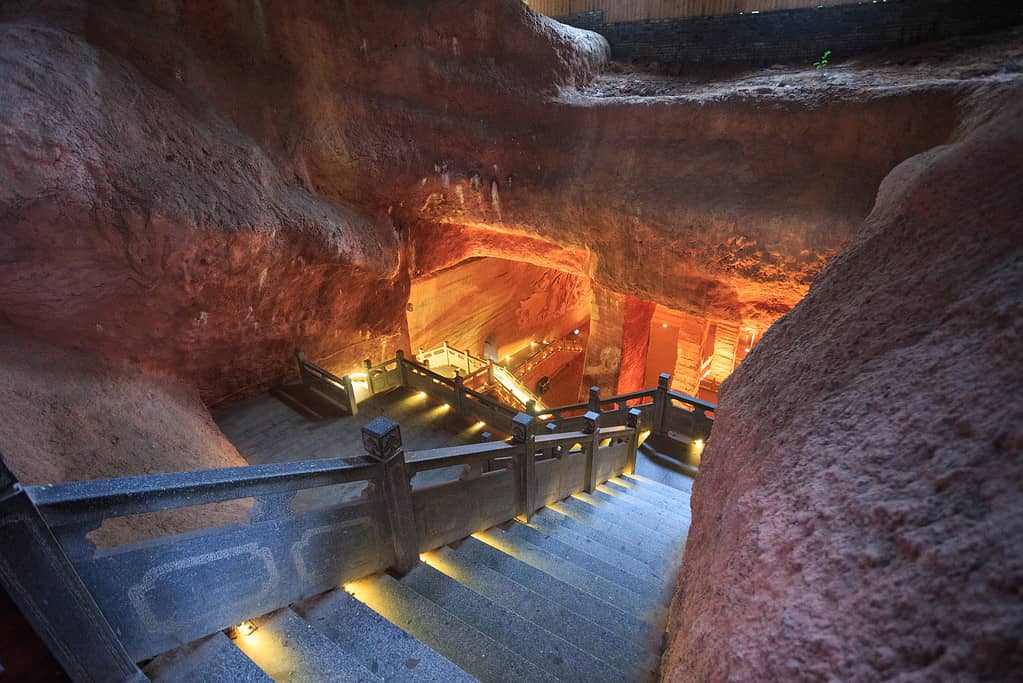
The Longyou Caves in the Zhejiang Province of China hold great mystery for archaeologists.
©Zhangzhugang / CC BY-SA 4.0 https://creativecommons.org/licenses/by-sa/4.0 – Original / License
2. Miao Room
The Largest Cave in China
China’s Miao Room cavern is not only the largest cave chamber in the country, but it’s also the largest in the world. It measures 353 cubic feet in volume (roughly the size of 4312 Olympic-sized swimming pools!) and covers 1.27 million square feet (the equivalent of 22 football fields).
The Miao Room Chamber is part of the Gebihe cave system beneath the Ziyun Getu He Chuandong National Park.
3. Xiaozhai Tiankeng
The Deepest Cave in China
The Xiaozhai Tiankeng in China is actually a giant sinkhole and the world’s deepest. The Xiaozhai Tiankeng is approximately a half-mile long, a half-mile wide, and a half-mile deep!
Located in Fengjie County of Chongqing Municipality in China, the Xiaozhai Tiankeng has steep, vertical walls. A 2,800-step staircase provides access to exploration.
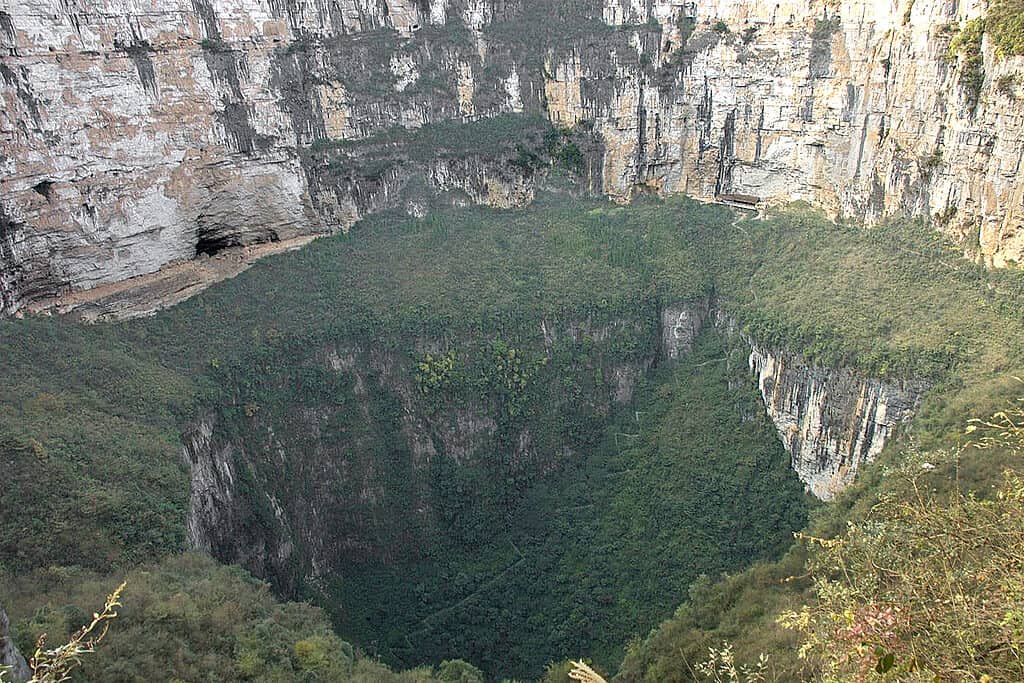
Xiaozhai Tiankeng is the world’s largest sinkhole and one of China’s most incredible caves.
©1,500 × 1,000 pixels, file size: 1.94 MB, MIME type: image/jpeg – Original / License
4. Reed Flute Cave
One of the Most Famous Caves in China
Located northwest of Guilin City, Reed Flute Cave is considered one of the most famous and incredible caves in China. It takes its name from the reeds, often used to make flutes, that grow outside the cave.
A popular tourist destination, the Reed Flute Cave dates back to the Tang Dynasty in 792 AD. Beautiful stalactites, stalagmites, and intricate rock formations are sights to behold inside the cave. Many of them mimic landmarks, natural objects, and mythical creatures and have been named accordingly.
One formation resembles the Statue of Liberty. Other popular formations include the Lion Rock and Sunrise, the Crystal Palace (named after the mythical Dragon King’s Crystal Palace), Pines in the Snow, and the Sky-Scraping Twin.
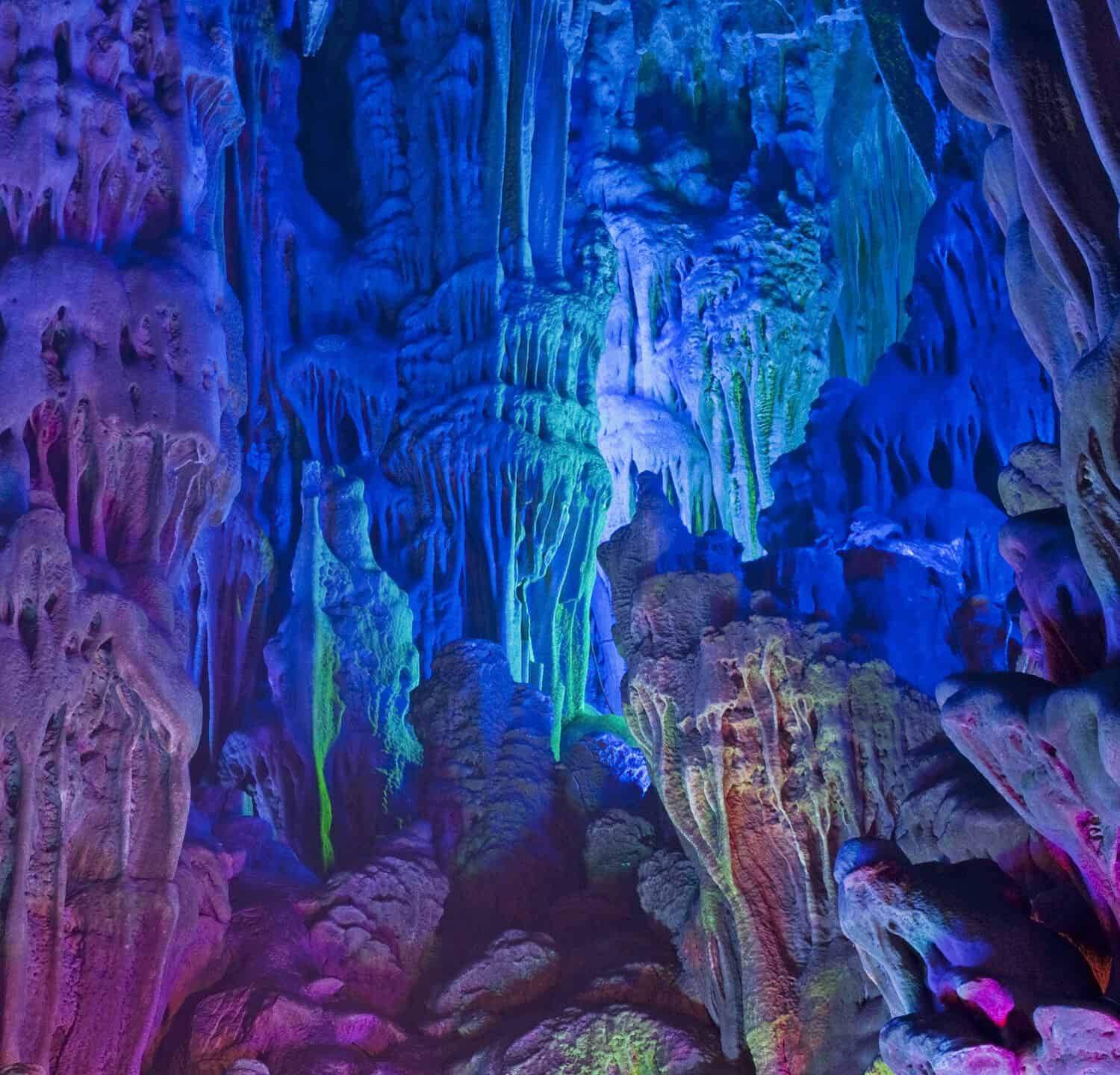
Rock formations in the Reed Flute Caves resemble various natural objects, including animals. This one is the Lion Rock and Sunrise, also called “Morning Sunrise Over the Lion Jungle.”
©DnDavis/Shutterstock.com
5. Tenglong Cave
The Largest Cave System in China
The Tenglong Cave is the largest cave system in China. Measuring a little more than 37 miles long with an area of 21.5 square feet, the Tenglong Cave has five layers and is considered one of the world’s “super caves.” You’ll find five peaks, ten chambers, and more than ten underground waterfalls in Tenglong Cave.
Tenglong Cave (translated as “soaring dragon cave”), located about four miles from Lichuan City, Hubei, China, is the source of the Qingjiang River.
During your visit to this site, you can enjoy a staged live-action performance highlighting Tujia ethnic culture or a laser show. Tenglong Cave is home to the world’s largest cave theatre, which offers these attractions to tourists daily.
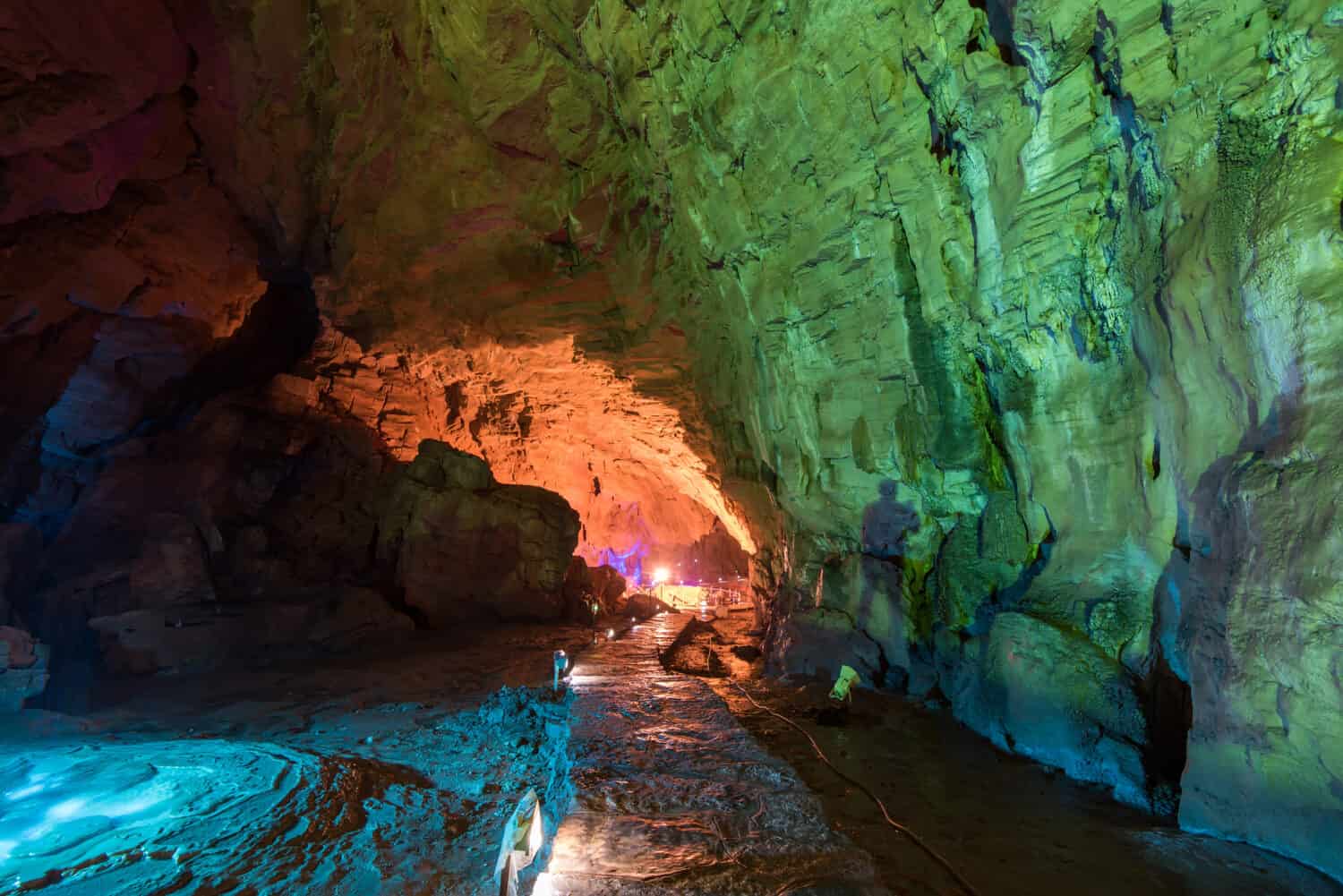
The largest cave system in China is the Tenglong Cave.
©asharkyu/Shutterstock.com
6. Yaodong (Loess Cave House)
Caves in China That People Live In
What happens when you combine human creativity, natural beauty, logistics, and necessity?
One outcome is making homes in caves. Located in the Loess Plateau, the yaodongs in northern China have been a permanent landscape fixture as human dwellings for more than 4,500 years. These dwellings are found in the provinces of Shanxi, Shaanxi, Gansu, and Henan and house more than 40 million people.
The yaodongs offer many benefits to their inhabitants. They are inexpensive to build and maintain. Constructed from the loess soil, which is abundant in the region, the cave houses are well insulated. They are comfortable year-round, which saves homeowners time, money, and resources.
Three types of cave houses exist in China. Loess cliff houses are dug directly into the loess cliffs of the Loess Plateau. Hole courtyards are dug into the ground, with rooms situated around an open courtyard. The “updated” brick houses are partially or wholly above ground and outdoors. They are stand-alone structures made of stone or brick, with loess soil covering their roofs.
Yaodongs played an interesting role in history. The yaodongs in Yan’an served as the Communist Party’s base of operations from 1935 to 1948.
If your trip to China brings you close to the yaodongs, you may be able to get first-hand experience of what it’s like to live in a cave. Many of them now operate as hotels and offer rooms for rent.

Cave houses (yaodongs) in Lijiashan village, Shanxi Province, are some of the most incredible caves in China.
©Silvia Campi/Shutterstock.com
7. Zhijin Cave
A Must-See Cave in China
Don’t miss visiting the uniquely beautiful Zhijin Cave, which owes its claim to fame to the more than 40 different types of karst formations found there. Nicknamed the “Karst Museum,” the Zhijin Cave has stalactites and stalagmites that range in height from approximately 131 to 229 feet. The Silver Rain Tree, which is made of transparent crystal, is one of the most popular rock formations. It is about 55 feet tall and resembles a flowering tree.
Originally called the Daji Cave, the Zhijin Cave was discovered in 1980. It’s located in Minzhai Village in Guizhou Province. Today, the Zhijin Cave is an important tourist attraction in the area.
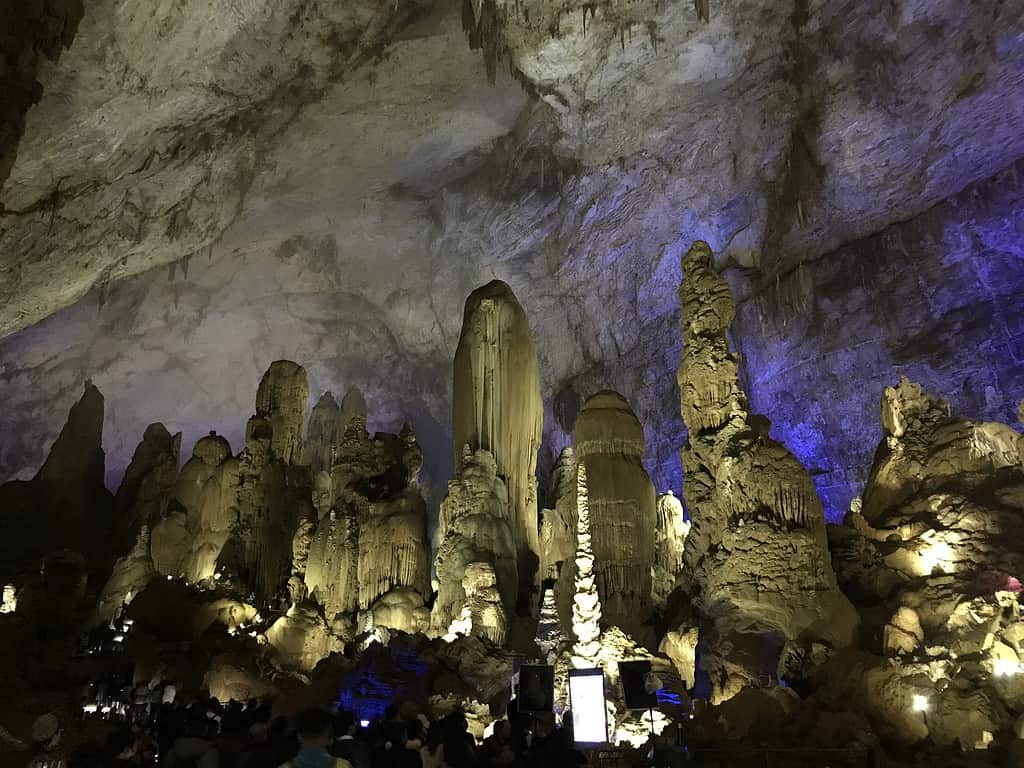
One of the defining features of Zhijin Cave is the Silver Rain Tree, a transparent crystal that reaches over 50 feet.
8. Yellow Dragon Cave
The Most Beautiful Cave in China
The Yellow Dragon Cave, or Huanglong Cave, is a natural wonder and the most beautiful cave in China. It features multi-colored lights illuminating gorgeous stalactites, stalagmites, stone pillars, stone flowers, and other rock formations.
The Yellow Dragon Cave takes its name from a legend that said a dragon and spirits once lived there. Four layers, including two water caves and two dry caves, make up almost 1.1 million square feet of explored area.
Naturally beautiful, thanks to stone chambers, wildlife, lakes, pools, and falls, the Yellow Dragon Cave offers visitors multiple sightseeing treasures.
Dragon Palace is the largest hall in Yellow Dragon Cave and offers a beautiful and varied display of 2,000 stalagmites. The subterranean Xiangshui River is almost 9,200 feet long and boasts Chinese giant salamanders.
Three gorgeous waterfalls seemingly come from nowhere, dropping from a ceiling that’s 98 feet high. They are appropriately called the “Tianxian Waterfall,” which means the water comes from the sky.
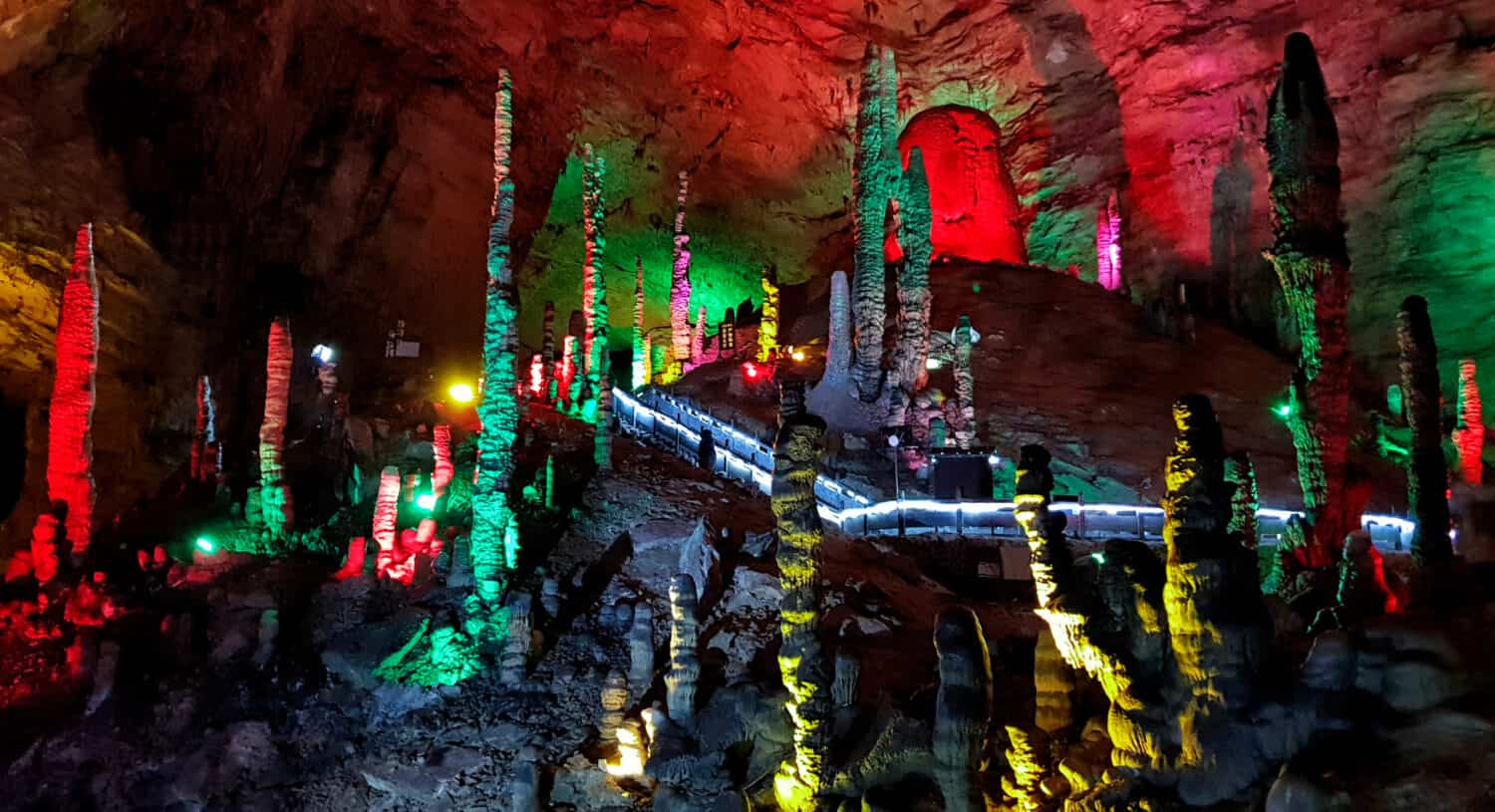
Located in Zhangjiajie, Hunan province, Yellow Dragon Cave is a popular tourist destination and is the longest cave in Asia.
©wonderlustpicstravel/Shutterstock.com
9. Furong Cave
A UNESCO World Heritage Site
Combining the best of both science and art, the Furong Cave has been regarded as “the most beautiful place underground” in China. One of the largest limestone caves in the world, Furong Cave, is located in Chongqing Wulong County.
The cave features nearly 70 different types of sediments and two types of rock: carbonate rock and sulfate salt. A variety of stalactites, stalagmites, stone pillars, and coral crystal flowers give the cave its unique beauty.
Furong Cave is the only cave in China to be named a United Nations Educational, Scientific and Cultural Organization (UNESCO) World Heritage Site. UNESCO World Heritage Sites are deemed to be culturally, historically, scientifically, or otherwise significant and receive international recognition as well as legal protection.
Discovered by local farmers in 1993, Furong Cave measures 9,337 feet long and 98-160 feet wide. More than 30 features make Furong Cave interesting and beautiful, including a stone “waterfall,” 50 vertical shafts more than 330 feet deep, a variety of helictites, and crystalline calcite and gypsum flowers.

Furong Cave in China is one of the most beautiful and largest limestone caves in the world.
©Sunday Panda/Shutterstock.com
10. Tianmen Cave (Heaven’s Gate Cave)
The Most Unique Cave in China
The Tianmen Cave is not like any of the other caves we’ve mentioned here, but it’s a fascinating and special landmark worthy of our list, nonetheless.
The highest naturally formed arch in the world, the Tianmen Cave measures 430 feet tall and 190 feet wide and sits 5,000 feet above sea level. That’s right. This cave is high and bright on the side of Tianmen Mountain. Visitors must climb the 999 steps (or take an escalator, cable car, or bus) to access its breathtaking views.
Because it looks like a mysterious portal into Heaven, the Cave has been nicknamed “Heaven’s Gate.” Appropriately, the steps that make up the “Stairway to Heaven” are 999. In Chinese numerology, nine represents eternal life.
Tinamen Cave is said to have been just an ordinary “run of the mill” cave until one side of the mountain collapsed, creating this special spiritual passageway in 263 AD.
Tianmen National Forest Park in Zhangjiajie, China, is home to Tianmen Mountain. Visitors looking to experience all the holy mountain has to offer may also enjoy the cliff-side paths, glass-bottomed skywalks, and the temple located at the top of Tianmen Mountain.

Visitors climb the 999 steps to the Tianman Cave, also known as the Heaven’s Gate Cave, on Tianmen Mountain.
©wonderlustpicstravel/Shutterstock.com
Summary of the 10 Most Incredible Caves in China
| Why This Chinese Cave Is Incredible | Cave | Location |
|---|---|---|
| Most Mysterious Caves | Longyou Caves | Zhejiang Province |
| Largest Cave | Miao Room | Ziyun Getu He Chuandong National Park |
| Deepest Cave | Xiaozhai Tiankeng | Fengjie County of Chongqing Municipality |
| Most Famous Cave | Reed Flute Cave | northwest of Guilin City |
| Largest Cave System | Tenglong Cave | Lichuan City, Hubei |
| Caves That People Live In | Yaodong (Loess Cave House) | Provinces of Shanxi, Shaanxi, Gansu, and Henan |
| Must-See Cave | Zhijin Cave | Minzhai Village in Guizhou Province |
| Most Beautiful Cave | Yellow Dragon Cave | Zhangjiajie, Hunan Province |
| UNESCO World Heritage Site | Furong Cave | Zhangjiajie, Hunan Province |
| Most Unique Cave | Tianmen Cave (Heaven’s Gate Cave) | Tianmen National Forest Park, Zhangjiajie, China |
Thank you for reading! Have some feedback for us? Contact the AZ Animals editorial team.








